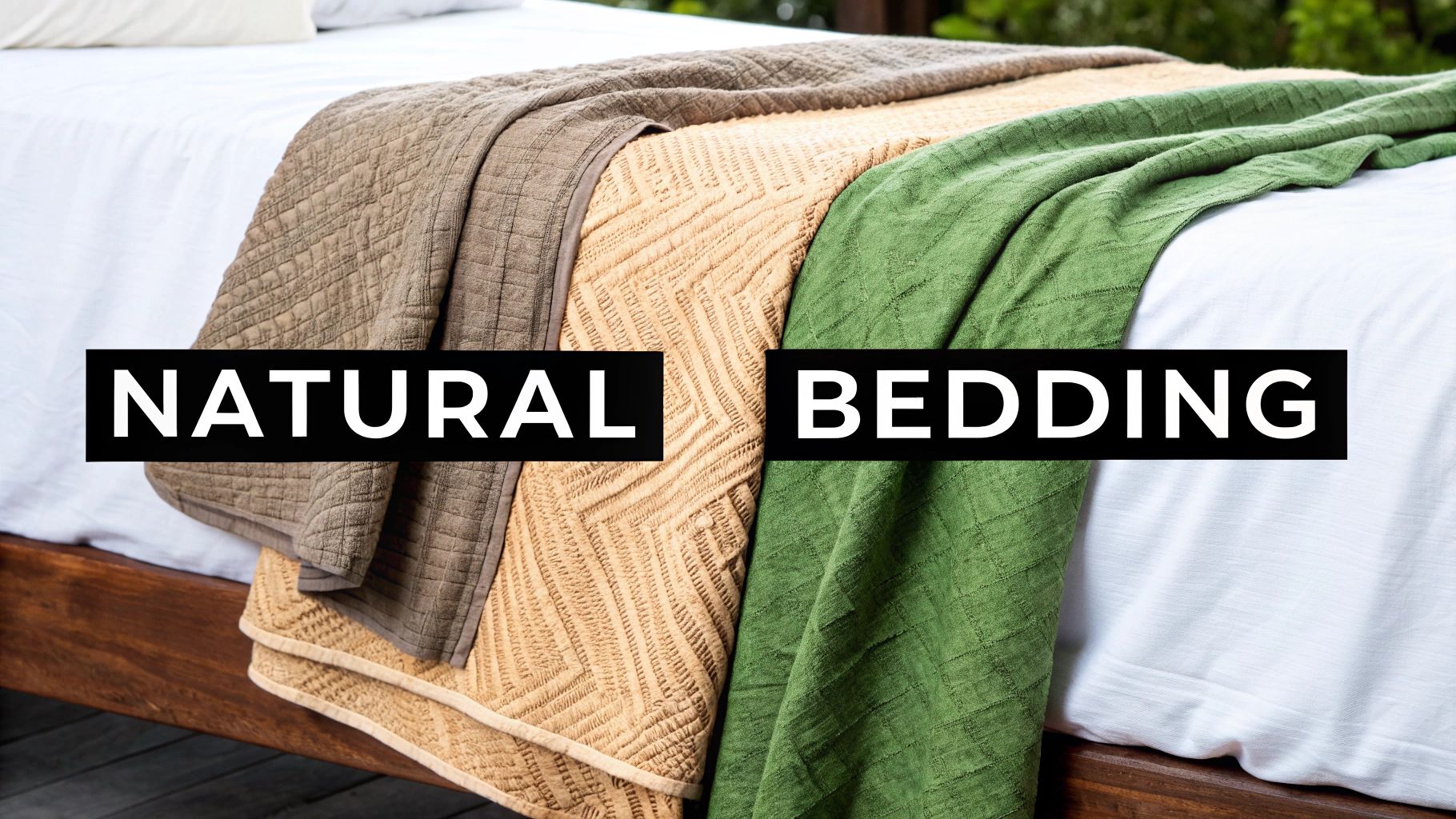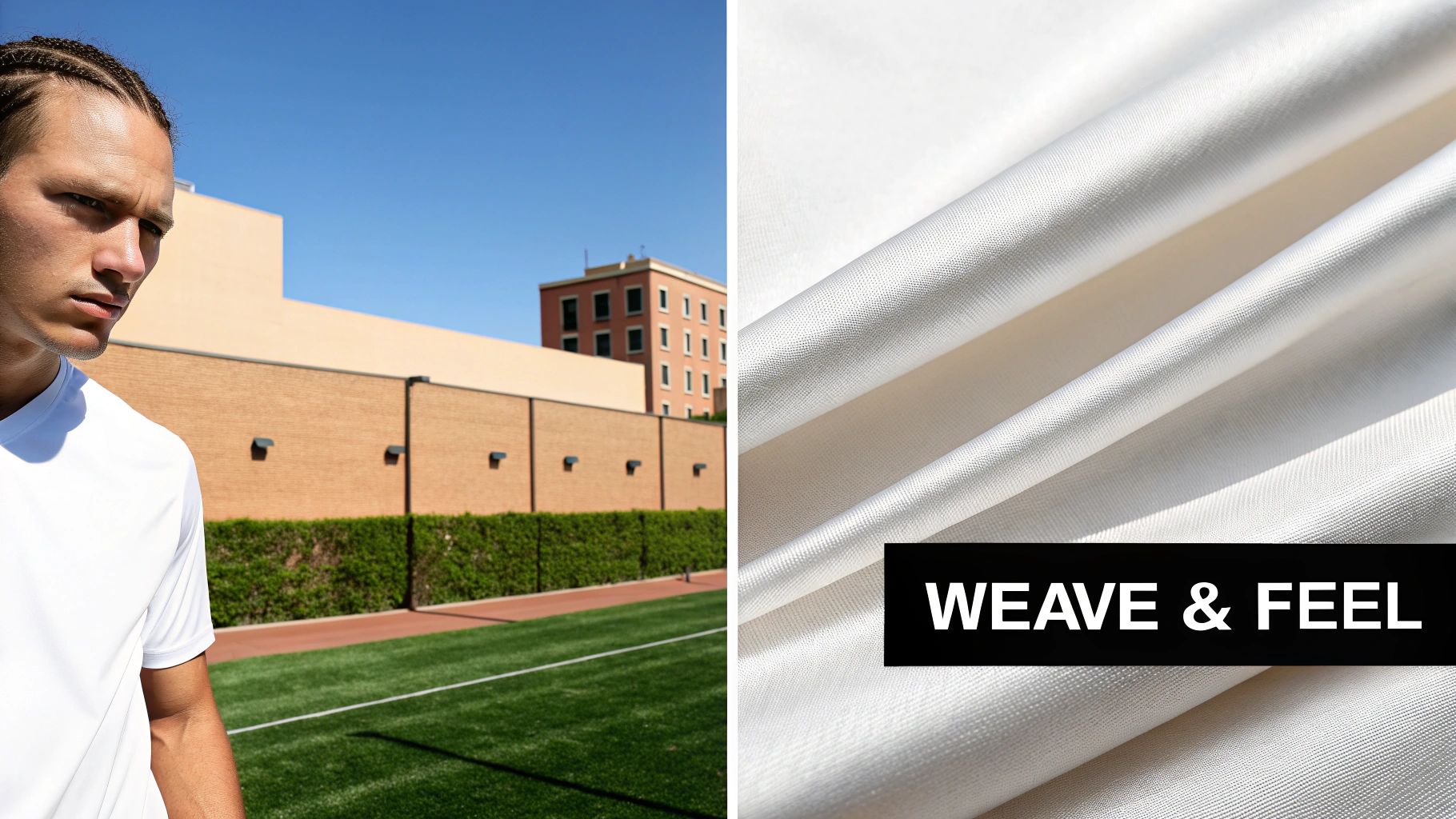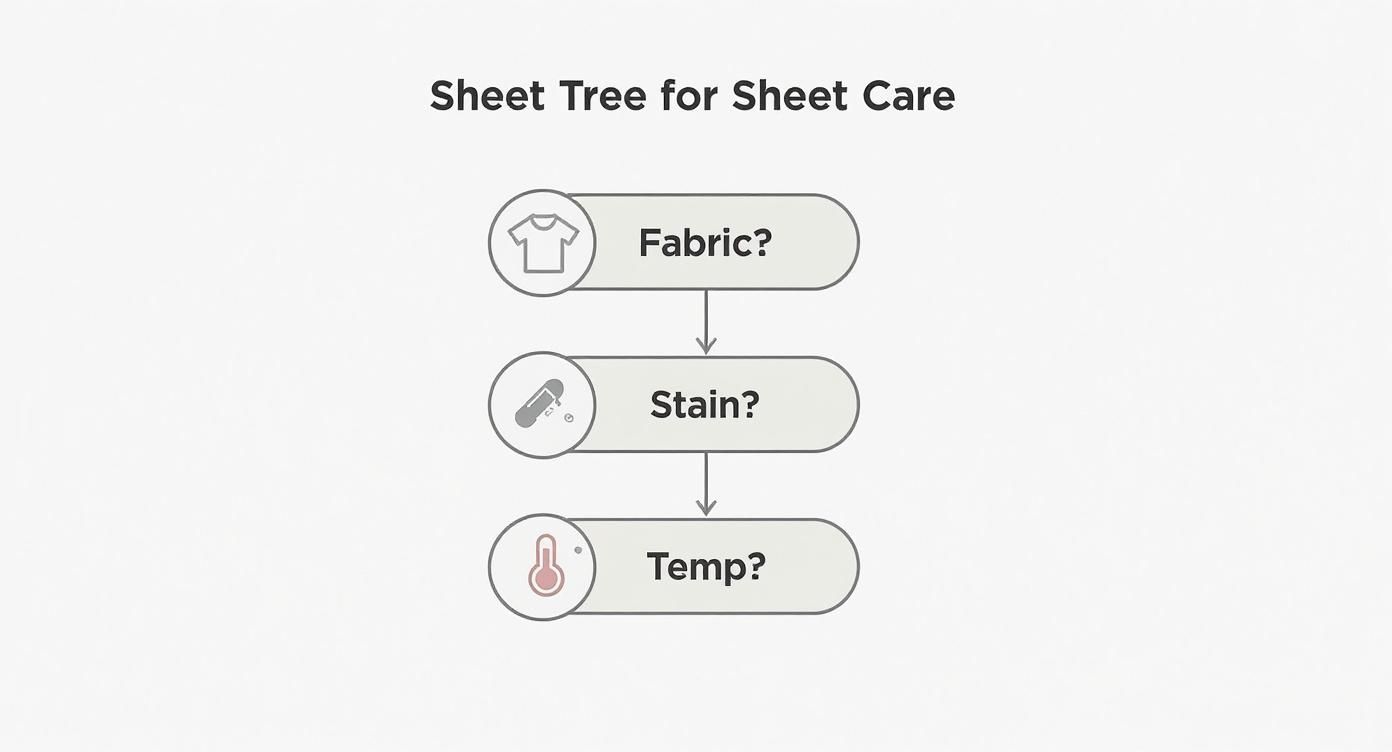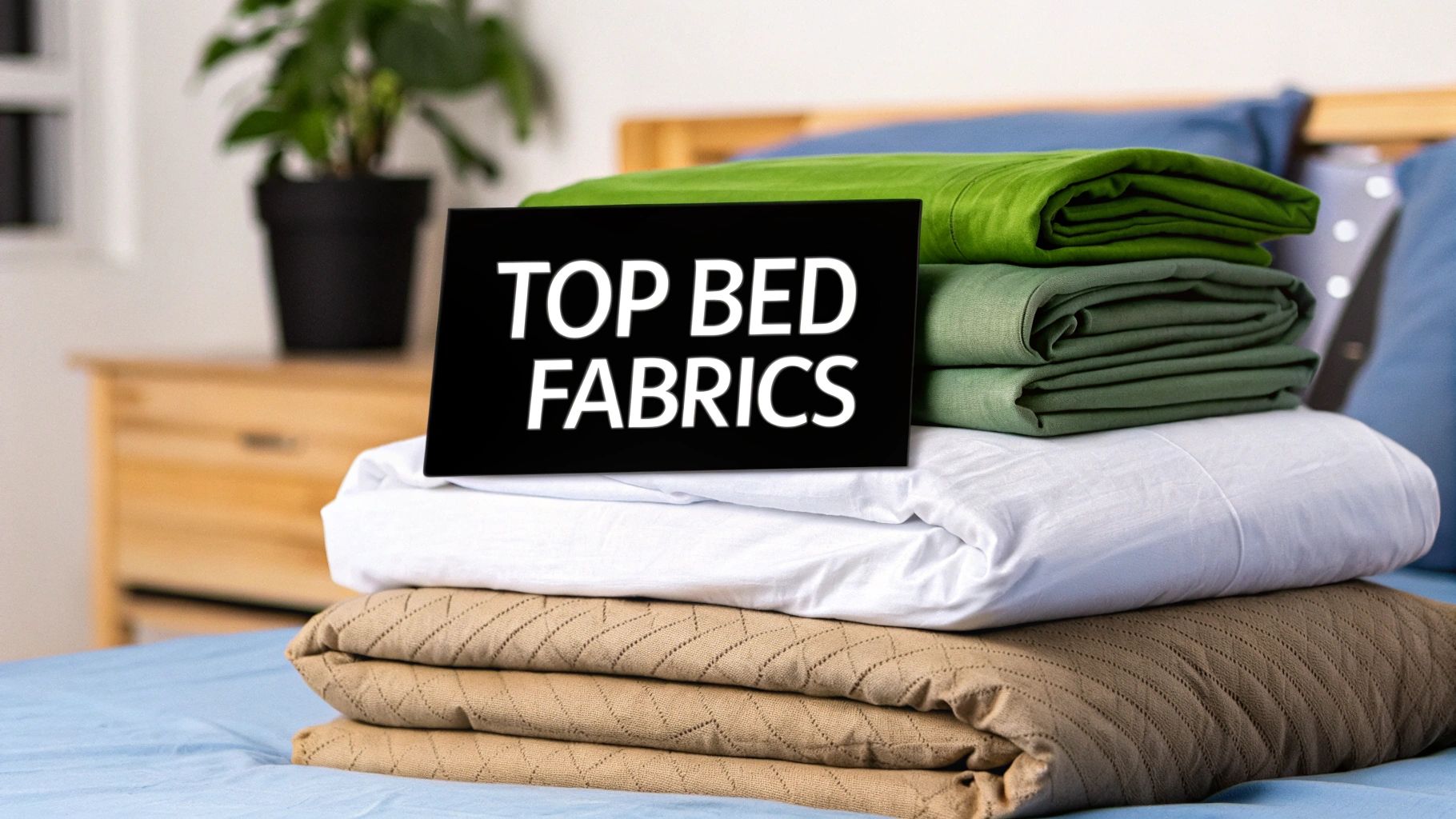When it comes to choosing the best fabric for your bed sheets, there is no single right answer. It all comes down to what feels best to you. Whether you love the crisp, cool touch of cotton percale, the silky smooth glide of bamboo, or the relaxed, breathable feel of linen, the perfect material is simply the one that helps you get your best night's sleep.
Your quick guide to dreamy bed sheet fabrics
Stepping into the world of bedding can feel a bit overwhelming with all the choices out there. But do not worry. Think of this less as a complicated decision and more as a journey to discover your personal sleep preference. The goal is to find a fabric that matches your sleeping style, how hot or cold you get at night, and the kind of texture you want to sink into after a long day.
This guide will act as your friendly starting point. We will cut through the jargon and get straight to what matters, comparing the most popular materials so you can easily spot which one sounds like your perfect match.
Making an informed choice
Getting a handle on the basics of each material is the key to making a choice you will be happy with for years. Every fabric brings its own unique blend of texture, breathability, and durability to the table. Each of these qualities can make or break your sleep experience. For example, if you are a hot sleeper, you will feel worlds better on breathable linen or percale than on a fabric that traps heat.
Before we get into the details, take a moment to think about what you really want from your bedding. Is it unparalleled softness, superb temperature control, or perhaps sheets that are a breeze to look after and will last for ages? Knowing your priorities will help you narrow down the options. For a closer look at what separates good bedding from great bedding, you can explore our insights on finding truly luxurious bed linens.
A great night's sleep often starts with the simple choice of fabric. The right sheets can help regulate your body temperature, soothe your skin, and create a welcoming retreat, transforming your bed into a true sanctuary.
To make things even clearer, here is a quick comparison of the most popular choices. Use this table to see how different fabrics stack up against each other at a glance.
Bed sheet fabrics at a glance
| Fabric Type | Best For | Feel | Breathability | Durability |
|---|---|---|---|---|
| Cotton | All round comfort | Crisp and cool or soft and smooth | High | High |
| Linen | Warm sleepers | Relaxed, lightly textured | Excellent | Very High |
| Bamboo | Sensitive skin | Silky, very soft | High | Medium |
| Tencel™ | Eco conscious shoppers | Exceptionally smooth, soft | Excellent | High |
| Microfibre | Busy families | Ultra soft, lightweight | Low | High |
This simple breakdown should give you a good idea of where to start your search for the perfect sheets. Now, let’s take a closer look at what makes each of these fabrics so special.
The timeless appeal of natural bedding fibres
When you picture sinking into a truly comfortable bed, what comes to mind? For most of us, it is the feel of natural fibres. These materials, sourced directly from nature, have been the cornerstone of quality bedding for centuries, and for good reason. They work with your body, not against it, offering a level of breathability, softness, and durability that synthetic fabrics often struggle to replicate.
Natural fibres like cotton and linen are fantastic at managing moisture and regulating temperature. This means they help keep you cool and dry on a balmy night but also cosy when it is chilly outside. It is this innate performance that makes them such a beloved choice in homes across the UK.
This focus on high quality, natural materials is far more than a fleeting trend. The UK bed linen market was valued at a staggering USD 1,820.45 million in 2024, with sheets and mattress covers making up the single largest segment. It just goes to show how much we prioritise the feel and quality of the fabrics we sleep on every night, with cotton varieties often leading the pack.

Classic cotton: The all round favourite
There is no doubt about it, cotton is the most popular and versatile bedding fabric out there. It is a true all rounder, loved for its softness, breathability, and everyday strength. But not all cotton is created equal, and knowing the difference is the secret to finding your perfect set.
The key to brilliant cotton lies in the length of its fibres, known as the 'staple'. Longer staples can be spun into finer, stronger, and smoother yarns, which in turn creates more luxurious and durable sheets.
Here are the main types you will come across:
- Upland Cotton: This is your standard, everyday cotton. It has shorter fibres, making it a perfectly good and affordable option, though it will not feel as soft or last as long as premium varieties.
- Pima Cotton: Grown mostly in the Americas, Pima has long staple fibres that create a wonderfully soft fabric with a subtle, elegant sheen. It is a fantastic step up in quality and durability.
- Egyptian Cotton: Often hailed as the gold standard, genuine Egyptian cotton is grown in the fertile Nile River Valley. Its extra long staple fibres produce exceptionally fine and strong yarns, resulting in bedding that is both incredibly luxurious and built to last.
Choosing a high quality cotton like Pima or Egyptian is an investment in your comfort. The initial cost might be higher, but the superior softness and durability mean you will enjoy a better sleep experience for years to come.
Laid back linen: The breathable wonder
If you are a warm sleeper or just adore a relaxed, lived in aesthetic, then linen could be your perfect match. Made from the fibres of the flax plant, linen is one of the oldest and most treasured textiles in the world. Its naturally open weave makes it exceptionally breathable, letting air circulate freely and moisture evaporate in a flash.
This quality makes linen the ultimate choice for staying cool and comfortable during warmer months or for anyone prone to overheating at night. It is also naturally hypoallergenic and, best of all, gets softer and more supple with every single wash, developing a beautiful, gentle drape over time.
Of course, one of the great debates in bedding is the classic face off between these two materials. While cotton offers a smoother, crisper feel from the start, linen provides a uniquely textured and airy experience. If you are weighing your options, our detailed comparison of linen versus cotton bedding can help you decide which is right for your sleeping style.
Why natural fibres matter for sleep
Opting for natural fibres is about more than just how they feel to the touch. It is about creating a healthier, more comfortable sleep environment.
Because materials like cotton and linen are so absorbent, they wick moisture away from your skin, preventing that clammy feeling on humid nights. Their breathability also helps your body temperature remain stable throughout the night. This leads to deeper, more restorative sleep, free from the frustrating interruptions of feeling too hot or too cold. It is this simple connection to our wellbeing that gives these timeless fabrics their enduring appeal.
Exploring modern and eco friendly fabrics
While cotton and linen have long been the stars of the bedding world, a new generation of fabrics is now offering incredible comfort with a modern twist. These materials often bring unique benefits, from silky softness to impressive sustainability credentials, making them fantastic choices for today’s homes. If you are looking for something a little different, these innovative options might be just what you need for a perfect night’s sleep.
Many of these newer textiles are created using advanced production methods that are kinder to the planet. They prove that you do not have to choose between luxury and making a thoughtful purchase for your home.
Bamboo for silky softness
Imagine a fabric that feels as smooth as silk but is as practical as cotton. That is the magic of bamboo. Sheets made from bamboo viscose or rayon are celebrated for their exceptionally soft and fluid drape, which feels wonderful against the skin.
This fabric is a dream come true for anyone who gets too warm at night. Bamboo is naturally brilliant at wicking moisture away from your body, helping you stay dry and comfortable even on the balmiest evenings. It is also hypoallergenic, making it a gentle and soothing choice for people with sensitive skin or allergies.
Tencel™ Lyocell the sustainable star
If you prioritise making eco conscious choices without sacrificing a hint of luxury, Tencel™ is a name you should know. This fabric, a brand of lyocell, is made from sustainably sourced eucalyptus wood pulp. The production process is remarkably clean, using a closed loop system that recycles over 99% of the water and solvents used.
But its green credentials are just the beginning. Tencel™ sheets are incredibly soft, breathable, and even more absorbent than cotton. This means they are brilliant at temperature regulation, keeping you cool when it is warm and comfortable when it is not. The fabric’s smooth surface is also very kind to sensitive skin. For those prioritising environmental impact, exploring a guide to sustainable fabrics can steer your choices towards more eco friendly options.
Microfibre for practicality and ease
For busy households, children’s bedrooms, or anyone seeking a budget friendly option that performs well, microfibre is a fantastic solution. This synthetic material is made from extremely fine polyester fibres, creating a fabric that is surprisingly soft, lightweight, and durable.
Microfibre’s main strengths lie in its practicality. It resists wrinkles, washes beautifully, and dries very quickly, making laundry day much simpler. While it is not as breathable as natural fibres, its durability and stain resistance make it a smart choice for everyday life.
When choosing a modern fabric, think about what matters most to you. Is it the unmatched softness of bamboo, the eco friendly promise of Tencel™, or the easy care nature of microfibre? Each offers a distinct benefit for a better night’s rest.
Understanding how these materials fit into a broader picture of sustainable living is becoming more important for many of us. If you are interested in how fabric choices can extend to other parts of your home, you might find it helpful to learn more about the benefits of organic bed linens and how they contribute to a healthier sleep environment. This wider perspective helps in making choices that are good for you and for the planet.
Ultimately, whether you are drawn to the natural charm of cotton or the innovative feel of bamboo, finding the best fabric for bed sheets is about matching the material to your personal comfort needs. These modern options simply give you more wonderful choices to explore on your journey to a perfect night’s sleep.
How weave and thread count shape your comfort

Choosing the right fibre is a brilliant start, but the secret to how your sheets truly feel lies in how those fibres are woven together. The weave is like the recipe that turns simple threads into a specific texture, be it crisp and cool or silky and smooth. It directly influences everything from breathability to the way the fabric drapes over you.
Think of it like baking bread. You can use the same flour to make a light, airy ciabatta or a dense, close textured loaf. In the same way, the very same cotton can be transformed into completely different fabrics just by changing the weave. Understanding this little secret helps you look beyond the label and choose sheets based on the precise feel you love.
Percale and sateen: The two main styles
When it comes to cotton bedding, you will almost always run into two main players, percale and sateen. Each offers a completely different experience, so knowing which one you prefer is key to finding your perfect sheets.
Percale is famous for its crisp, cool, and matte finish, much like a freshly pressed shirt. It is made using a simple one thread over, one thread under grid pattern. This tight, straightforward weave makes the fabric feel wonderfully light and airy, which is why it is a fantastic choice for hot sleepers or anyone who loves that classic, luxury hotel sheet feel.
In contrast, sateen has a much silkier, smoother handle with a gentle lustre. It is constructed with a one thread under, three or four threads over pattern. This structure exposes more of the thread's surface, creating that signature soft sheen and a luxuriously drapey feel. Sateen sheets feel slightly warmer and cosier to the touch, making them ideal for cooler nights or for anyone who craves a buttery soft texture.
To help you decide which finish is right for you, here is a simple breakdown of how they compare.
Percale weave vs sateen weave
This table breaks down the key differences between percale and sateen weaves to help you decide which finish is right for you.
| Feature | Percale Weave | Sateen Weave |
|---|---|---|
| Feel | Crisp, cool, and matte | Silky, smooth, and lustrous |
| Best For | Hot sleepers and summer nights | Those who love a soft, cosy feel |
| Breathability | Excellent, very airy | Good, but slightly warmer |
| Look | Understated and classic | Elegant with a subtle sheen |
| Durability | Very strong and gets softer over time | Prone to snagging if not cared for properly |
Ultimately, the choice between percale and sateen boils down to personal preference. One is not better than the other, they just offer distinct sensory experiences.
Demystifying thread count
Alongside weave, you will always see a "thread count" number on the packaging. For years, we have been told that a higher number automatically means better quality, but this is one of the biggest myths in the bedding world.
So, what does thread count actually mean? It is simply the total number of threads, both lengthwise and widthwise, woven into one square inch of fabric. While it does give an indication of how tightly woven the material is, it says absolutely nothing about the quality of the threads themselves.
A sheet with a 300 thread count made from high quality, long staple cotton will feel far more luxurious and last much longer than a 1,000 thread count sheet made from short, weak fibres. In fact, excessively high thread counts are often just a marketing gimmick, achieved by twisting multiple low quality threads together. This can result in a heavy, dense fabric that does not breathe well.
The quality of the fibre is always more important than the thread count. A well made sheet in the 200 to 500 thread count range usually offers the perfect balance of softness, breathability, and durability.
Instead of chasing big numbers, focus on the quality of the cotton and the type of weave that appeals to you. This approach will help you make a much better investment in your comfort. For a more detailed guide, you can learn all about finding the best thread count for your sheets in our journal.
Caring for your bed sheets so they last longer
Once you have found the perfect sheets, a little care goes a long way in keeping them feeling wonderful for years. Looking after your bedding properly protects the fibres and preserves the colour, ensuring you get that fresh, clean feeling night after night. Think of it as a simple step that protects your investment in good sleep.
The right care routine really depends on the fabric you have chosen. Hardy cottons can handle a different approach to delicate silks or rustic linens. Just a few small adjustments to your washing habits can make all the difference, extending the life of your favourite sheets and keeping them looking as good as new.
Washing your sheets the right way
A good starting point for most fabrics is a gentle wash cycle. This simple choice prevents unnecessary stress on the seams and fibres, which is the first step to a longer life for your bedding.
For cotton and microfibre, a wash temperature of 40°C is usually the sweet spot. It is effective enough to clean thoroughly while still being gentle on the fabric. If you have opted for more delicate materials like bamboo or Tencel™, it is best to stick to a cooler 30°C wash to protect their soft texture and prevent any potential shrinkage.
Of course, always check the care label on your sheets before that first wash, it is the most accurate guide you will get.
I always recommend using a mild, liquid detergent over harsh powders. Powders can sometimes leave a residue on the fabric, which can make your lovely soft sheets feel slightly stiff or scratchy over time.
To tumble dry or to line dry
Next up is drying. Whenever possible, line drying is the champion for almost any fabric. Fresh air helps keep sheets smelling clean, and the sunlight acts as a natural disinfectant, which is a fantastic bonus for white bedding.
If you need to use a tumble dryer, always choose a low heat setting. High temperatures are the enemy of delicate fibres in materials like cotton and linen, causing them to weaken and shrink. Here is a pro tip, take your sheets out of the dryer while they are still slightly damp and hang them to finish drying naturally. This simple trick really helps to minimise wrinkles.
Special care for delicate fabrics
Some materials just need a little extra attention to stay at their best. Linen, for instance, famously gets softer with every wash, but it thrives when it has plenty of space in the washing machine to move around.
For luxurious silk bed sheets, understanding how to hand wash silk is absolutely vital to preserve their delicate texture and sheen. This gentle approach helps maintain the natural lustre that makes silk so special. A little extra care ensures these premium materials last for years, making your investment worthwhile.
Making the right choice for your home
So, we have explored the different fabrics and weaves. Now, let's tie it all together and help you pick the perfect sheets for your home with real confidence. Finding the best fabric is not just about what feels nice, it is about matching the material to your life and finding that sweet spot between personal comfort and practical needs.
A brilliant first step is to think about how you sleep. Are you someone who is constantly kicking off the covers, feeling too warm? If so, a crisp, breathable fabric like linen or cotton percale will be a game changer. For those with sensitive skin, a naturally hypoallergenic material like bamboo could be the soothing answer you have been searching for.
Matching sheets to your lifestyle
Your daily routine has a surprisingly big say in this decision. For a bustling family home or anyone who feels like there are not enough hours in the day, low maintenance sheets are a true blessing.
Materials like microfibre are fantastic here because they naturally resist wrinkles and dry in a flash, making laundry day far less of a chore. If you are curious, we have a guide that digs deeper into what makes microfibre bedding such a practical choice.
On the flip side, if your goal is to create a luxurious, hotel like sanctuary in your bedroom, investing in high quality Egyptian cotton or silky smooth Tencel™ can completely transform your sleep. Yes, they cost a bit more upfront, but their incredible feel and durability offer fantastic value in the long run.
Here is a simple rule I always follow, invest in the best quality your budget allows. High quality sheets do not just feel better, they stand up to repeated washing and will outlast cheaper alternatives by years, ultimately saving you money.
The infographic below offers a great visual guide on how to approach care based on different fabrics and common situations.

As you can see, just a few simple questions can point you towards the perfect care routine, no matter what sheets you choose.
Peace of mind with certifications
Finally, a quick tip is to keep an eye out for certifications like OEKO-TEX®. This label is your assurance that every single component of the sheet, from the thread right down to any buttons, has been rigorously tested for harmful substances. It is a straightforward way to know your bedding is safe for you and your family.
Thanks to the boom in online shopping, finding and comparing certified products is easier than ever. In fact, e-commerce is the UK's fastest growing channel for bed sheet sales, boasting a growth rate of 10.38%. This gives you a massive range of choices right at your fingertips. For those interested in the numbers, you can read the full research on the UK bed linen market at mordorintelligence.com.
By keeping these simple, practical points in mind, you will be well on your way to choosing sheets you will love for years to come.
Your bed sheet questions, answered
Picking out new bedding often raises a few questions. To help you feel completely confident in your choice, we have put together clear, straightforward answers to some of the queries we hear most often. Let's clear up any lingering doubts you might have.
What is the best fabric for hot sleepers?
If you tend to overheat at night, your best bet is a fabric that is breathable and moisture wicking. Linen is a fantastic choice, it is incredibly airy and brilliant at absorbing moisture, helping you stay fresh and dry.
Cotton with a percale weave is another excellent option, known for its crisp, cool feel against the skin. You might also want to look at modern materials like bamboo or Tencel™. Both are naturally temperature regulating and great at pulling moisture away from your body, ensuring you have a much more comfortable night's sleep.
Does a higher thread count mean better quality?
Not necessarily, this is one of the biggest myths in the world of bedding. While thread count refers to the number of threads in one square inch of fabric, the quality of the fibre is far more important.
A sheet with a 300 thread count made from high quality, long staple cotton will feel significantly softer and prove more durable than a 1,000 thread count sheet woven from shorter, lower grade fibres. A great rule of thumb is to look for a thread count between 200 and 500. Always prioritise the quality of the material over the numbers on the label.
Remember, the quality of the yarn is the true sign of luxury. A beautifully made, lower thread count sheet will always outperform a poorly made, high thread count one.
How can I spot genuine Egyptian cotton?
True Egyptian cotton is a premium material, and for good reason. It comes from a specific plant grown along the Nile River Valley that yields extra long fibres, which are then spun into incredibly soft and strong yarns.
To make sure you are buying the real deal, look for the official Cotton Egypt Association™ trademark on the packaging, it is a distinctive gold triangle logo. Be wary of vague descriptions like ‘Egyptian feel’ or ‘Egyptian blend’, as they can be misleading. Your best course of action is to purchase from a reputable UK brand known for its quality bedding. That is a reliable way to get authentic sheets that will last for years.
Ready to build your perfect sleep sanctuary? Explore the complete collection of cosy bedding and stylish home essentials from Morgan and Reid today and discover comfort that truly feels like home. Find your perfect match at https://www.morganandreid.com.



Share:
What Is Fleece Fabric? A Simple Guide
A Complete Guide to UK Bedding Size Dimensions